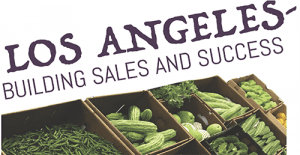The juxtaposition of the hardworking Los Angeles Wholesale Produce Market butting up against a complex of millennial work-live-play, separated by nothing but a chain link fence, is a little jarring but reflective of the future and the irresistible attraction of Los Angeles urban real estate.

“We have space on the market where we service smaller customers,” says James Alvarez, president of Olympic Fruit & Vegetable Distributors/Coast Tropical. “It’s easier to sell distressed product there, and there’s more cash business. But most of our business is delivered out of our big warehouse a few blocks away. We’re all owners and our warehouse is gold. With Staples Center nearby, the Arts District, Fashion District, and people moving into the area in droves, there’s a lot of activity and the Market is a big cash cow for owners.”
There is always speculation about what will happen in the neighborhood adjacent to the market where so many produce companies have warehouses.
“The real estate market is so hot within a three-mile radius of our warehouse,” Sam Thakker, sales manager at Daaks International LLC, which is located just off the market.
“Cannabis labs are taking up space,” Thakker says. “Rents are going up 30 to 40 percent and landlords are jacking the rates from $2.50 per square foot up to $8 per square foot. If you can find anything under $3 per square foot, grab it, because that’s a bargain.”
Thakker also reports there’s talk that the market may move inland to Ontario, CA, nearly 40 miles to the east, but a source close to the market assures that even in the unlikely event the partners were inclined to move, it would be 10 years or more before it could be realized.
The Los Angeles Terminal Market (also known as the Seventh Street Market) opened in 1917 at the terminus of the Southern Pacific Railroad as the city’s marketplace for wholesale fruits and vegetables. From the 1920s to the 1980s, there were two major wholesale produce markets in Los Angeles, each named for the streets they bordered — Seventh Street and Ninth Street market, respectively.
To update and consolidate operations, the Los Angeles Wholesale Produce Market or “new” market was opened in 1986. It was adjacent to the Seventh Street Market, which now consists of smaller “mom and pop” produce vendors and their eclectic customers.
The Ninth Street Market, also known as the city market, lost its produce tenants over the years and was ultimately converted into warehouses with other uses.
New York developer Atlas Group purchased the historic buildings surrounding the old terminal market in 2014 and began transforming them into DTLA (Downtown LA), a collection of office space, retail, dining, and even a health club. Monday through Saturday the terminal market operates as it has since the early 20th century, but on Sundays it turns into “Smorgasburg LA,” a weekly festival of food and craft booths.
This is an excerpt from the most recent Produce Blueprints quarterly journal. Click here to read the full article.


